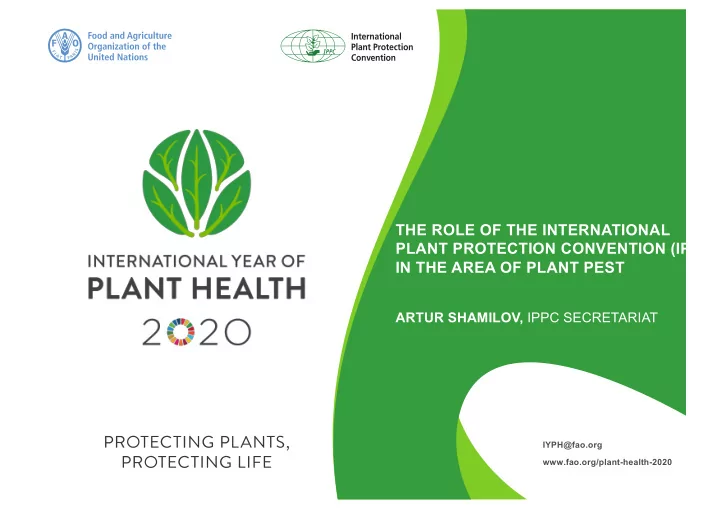

31/05/2018 THE ROLE OF THE INTERNATIONAL PLANT PROTECTION CONVENTION (IPPC IN THE AREA OF PLANT PEST ARTUR SHAMILOV, IPPC SECRETARIAT IYPH@fao.org www.fao.org/plant-health-2020
31/05/2018 Halyomorpha halys , the Brown Marmorated Stink Bug (BMSB)
31/05/2018 Xylella fastidiosa (Xf)
31/05/2018 History of the IPPC 1951 FAO agreed 1952 came into force 1989 SPS recognized our standards, guidelines and recommendations • 1992 FAO provided Secretariat, • started setting standards 1997 revision adopted by FAO 2002 came into force 183 contracting parties
31/05/2018 Who we are? • The IPPC is the global international treaty for protecting plant resources (including forests, aquatic plants, non- cultivated plants and biodiversity) • 183 contracting parties • The IPPC is governed by the IPPC Commission on Phytosanitary Measures (CPM) • It is the only standard setting body for phytosanitary measures recognized by the World Trade Organization's (WTO) the Agreement on the Application of Sanitary and Phytosanitary Measures (the SPS Agreement)
31/05/2018 Strategic Framework Mission : Protect global plant resources and facilitate safe trade Vision: The spread of plant pests is minimized and their impacts within countries are effectively managed Goal: All countries have the capacity to implement harmonised measures to prevent pest introductions and spread, and minimise the impacts of pests on food security, trade, economic growth, and the environment
31/05/2018 What are the IPPC objectives? Protect sustainable agriculture and enhance global food security Protect the environment, forests and biodiversity from plant pests Facilitate economic and trade development Develop phytosanitary capacity for members
31/05/2018 What does the IPPC do? IPPC helps protect plant resources from pests and diseases and ensure food security by: o protecting farmers from economically devastating pest outbreaks o protecting the environment from loss of species diversity o protecting ecosystems from loss of viability and function as a result of pest invasions o protecting industries and consumers from the costs of pest control or eradication o facilitating trade through standards that regulate the safe movements of plants and plant products
31/05/2018 What the IPPC core activites ? • Standard Setting • Implementation and Capacity Development • Communication & International Cooperation
31/05/2018 The IPPC standards: International Standards on Phytosanitary Measures (ISPMs) ISPMs adopted (1993- March 2019) 42 ISPMs 29 diagnostic protocols 32 phytosanitary treatments 07 CPM Recommendations
31/05/2018 IPPC Standards ü General standards related to phytosanitary principles and providie guidance to NPPOs (e.g. on inspection and sampling of commodities). ü Standards on pest management, including guidance on surveillance, determination of pest status, pest reporting, pest eradication programmes and phytosanitary treatments. ü Standards on pest risk analysis and pest risk management. ü Trade-related standards, including phytosanitary certification and international movement of certain commodities, for example “seeds”.
31/05/2018 With whom we work • Contracting Parties and National Plant Protection Organisations • Regional Plant Protection Organisations • Agricultural Producers, Farmers, Exporters and Importers • FAO Divisions and Regional and Country Offices / Departments and other relevant International Organizations • Donor Agencies and Countries
31/05/2018 Contribution to UN SDGs • ending hunger • reducing poverty • protecting the environment • boosting safe trade and economic development
31/05/2018 International Year of Plant Health IYPH • 2015-04: At CPM-10 Finland proposed the establishment of an International Year of Plant Health. • 2017-07: The 40th Session of the FAO Conference adopted the proposal by Finland. • 2018-04: CPM-13 agreed to the skeleton of IYPH programme events and their associated estimated costs. • 2018-12: The UN General Assembly adopted the UN Resolution A/RES/73/252, proclaiming 2020 the IYPH and calling upon FAO, in collaboration with the IPPC, to lead the implementation of the Year.
31/05/2018 Promotion of IYPH globally (activities) • 2 December 2019: IYPH launch event in Rome • December 2019: IYPH launch event in New York • Dec. 2019 – Dec. 2020: IYPH photo competition • 30 March – 3 April 2020 : CPM-15 in Rome (Ministerial segment/declaration on 2 April 2020) • 5-8 October 2020: International Conference on Plant Health in Helsinki • 16 October 2020: World Food Day focused on Plant Health (tbc) • January 2021: IYPH closing event in Rome
31/05/2018 Contact us IPPC Secretariat Food and Agriculture Organization of the United Nations (FAO) Find us online www.ippc.int www.fao.org/plant-health-2020 ippc@fao.org
Recommend
More recommend